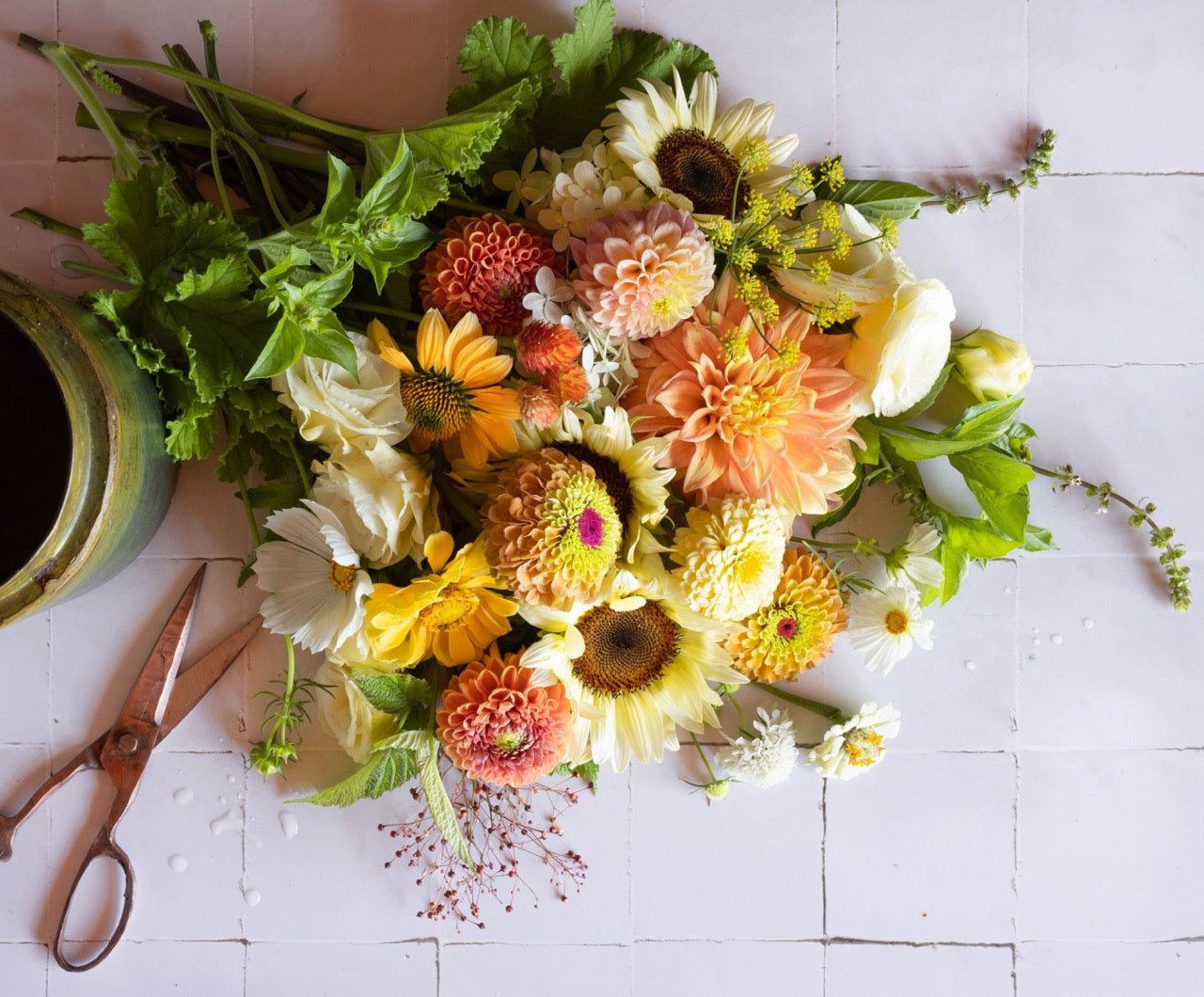My Journey to the Bouquet Blueprint™ : A Tale of Trials, Triumphs, and Tons of Flowers
Share
With flower farming, I learned pretty quickly that the actual growing of flowers was the easy part. The real puzzle? Figuring out how to put together those eye-popping, heart-stopping mixed bouquets for our farmers market fans and bouquet subscription customers without draining our bank account – or theirs. As the farm grew beyond the point where I could whip up all those bouquets myself, that “puzzle” became increasingly painful.
Creating the perfect mixed bouquet is both an art and a science, and our market and subscriber bouquets need to meet three, equally important criteria to meet this ideal. First, they have to be beautiful -- ready to drop into a vase and look stunning. Second, we have to provide the value that our customers are looking for. This doesn’t mean that the bouquets have to be inexpensive, but they do have to be worthy of the money that customers will spend on them. Lastly, we have to be able to produce the bouquets in a way that is sustainable – including financially sustainable – for our farm.

One of the criteria we strive to meet with our mixed bouquets is that they are vase-ready. Our customers don't have to spend time selecting flowers or arranging them -- they can just drop one of our bouquets in a vase and it will look beautiful.
It’s easy to meet any two of these criteria – packing a bouquet with tons of beautiful blooms, for example, will likely meet the first standard and will definitely meet the second – but missing the third objective just means that the flower farmer will eventually go out of business.
Pursuing the challenge of creating beautiful, garden-inspired bouquets that meet all three criteria has been an eight year-long, transformative journey. It has led to the creation of a revolutionary system known as the Bouquet Blueprint™ – an innovation born out of necessity, frustration, and a burning desire to bring beautiful, locally-grown flowers into our community in a way that would enable our farm to survive.

It's taken years to get here, but we now have a formula that enables anyone on the farm team to make a beautiful mixed bouquet of any size and color palette.
Here’s the story of how we turned a time-consuming, stress-filled process for creating mixed bouquets into a streamlined, harmonious operation that celebrates the diversity of our blooms, ensures every creation meets our high standards, and keeps sustainability – financial and otherwise – at the forefront.
The Early Days: When in Doubt, Just Add More Flowers
In the early days of the farm, making bouquets wasn’t just like cooking without a recipe, it was like trying to prepare a restaurant-quality menu when you don’t know what ingredients are in the pantry. We’d grab stems from the harvest buckets, purely going by what caught our eye, trying to create something roughly bouquet-sized and pretty.
As the bouquet-making went on into the night, the size of the bouquets would creep up in size, often resulting in the creation of “two-fisters” – arrangements so large they couldn’t be held in one hand. If we weren’t sure whether the bouquet was pretty enough, the solution was always the same: just add more stems.

In the early days, our bouquets were pretty, but they were also PACKED with blooms -- making them completely unsustainable from a financial standpoint, for our farm.
We also spent a ton of time searching for the “right” blooms to add, turning the bouquets in our hands to inspect them from multiple angles and decide what to add next. Given the time we spent on each arrangement, you would have thought we were crafting bridal bouquets. They were almost always beautiful, but our process was far from efficient.
What I quickly realized was that each of those overflowing, time-consuming bouquets was eating away at any hope of breaking even, let alone making a profit. I was lucky, in many ways, to still be such a small operation, at the time. Because when you’re selling a product at a loss, selling more of them doesn’t help – it just makes you lose money even faster.
The Whiteboard Approach: From Chaos to... Slightly More Organized Chaos
Our initial approach to assembling mixed bouquets in a more streamlined, disciplined way was still a manual, labor-intensive process. I would stand in front of a whiteboard, armed with the prior day’s harvest numbers, and embark on a complex dance of numbers. This included estimating stem costs, deciding on the bouquet's final price, and determining which flowers -- and how many of each one -- would look best together.

Turning a cooler full of just-harvested flowers into mixed bouquets is no small feat. Doing it in a way that is efficient and consistent -- and still creates a gorgeous end-product -- means having a system.
This method was fraught with inaccuracies due to ballpark pricing and human error in the calculations. It was also enormously time-consuming. I might find a great recipe, only to realize we didn’t have enough snapdragons to put one in every bouquet. Or I might discover that to use up all the zinnias, we would need to pack so many into a bouquet that there was no hope of hitting a break-even price, let alone a profitable one. I’d be forced back to square one.
These sessions were also really stressful. I tried to do all of the calculating before the rest of the farm team arrived, but if I hadn’t yet found the right formula, we’d lose even more time when others jumped in – trying to help but ultimately just bogging down the process in debates about whether we should use up all the anemones in mixed bouquets or try to sell them as straight bunches.
The Spreadsheet Era: Same Problems, Just with Better Math
Our next evolution involved the adoption of a spreadsheet system. I used the spreadsheet to track the number of flowers we’d harvested, and I started introducing more rigorous attention to stem prices, now that a computer was handling the math.
The beginnings of the Bouquet Blueprint™ started to emerge in this phase, as we began dividing the flowers used in bouquets into similar groups that allowed us to make substitutions – let’s use a stem of astilbe, for example, instead of a snapdragon – that didn’t throw off the look or price of the bouquet. We also used more accurate price and harvest numbers to better calculate the number of blooms we should be putting into a bouquet.
While this was a major step forward, the process remained cumbersome. It was still dominated by trial and error, as I plugged different values into the spreadsheet to try to hit a “sweet spot” where we used up available blooms, created aesthetically pleasing bouquets, and still hit the right price point. This trial and error was ridiculously time consuming, and didn’t alleviate the debates over flower substitutions and bouquet composition -- debates that drained our energy and inevitably left people feeling unheard and disheartened.

Bouquet-making day at the farm does NOT look like this (!) -- instead, we have a much longer assembly line and the whole set-up is designed for speed. This staged shot was taken by one of our favorite photographers (Erica D. Photography), who we hire every year to take gorgeous shots (like this one) of our team.
The Epiphany: Floral Roles Within a Bouquet
The true breakthrough came when we identified and characterized the distinct roles different flower types play within a bouquet. This insight led us to place every stem we grow into one of six categories: focal, foundation, filler, floater, finisher, and foliage. We started referring to these categories as the “6Fs” and this categorization became the cornerstone of the Bouquet Blueprint™ framework for building mixed bouquets. Placing each floral type into its proper category allows for a system of building bouquet recipes that balances creative freedom with the discipline necessary for making each bouquet both beautiful and economically viable.

The six flower types that make up the foundation of the Bouquet Blueprint™. We refer to them as the "Six Fs" because their names all start with the letter 'F.'
We quickly realized that the identification of the six floral types allowed us to stop doing some things that were taking lots of time – like harvesting more of particular types of flowers than we were really going to need to make beautiful bouquets. It also allowed us to stop drawing up multiple, detailed recipes that accounted for the fact that we didn’t want to use certain flowers – like rudbeckia or sunflowers – in every single bouquet, given their limited range of colors.
Instead, we could devise a single recipe that allowed for creative substitutions. For example, a recipe might call for two filler flowers, but whether those filler stems were yarrow, bupleurum, or feverfew (or a combination of both) was up to the bouquet maker.
The Bouquet Blueprint™ methodology also influenced the way we organized our bouquet-making operation, as the order of addition of 6F types to a bouquet started to became obvious. By placing the finisher flowers at the end of the assembly line, for example, we avoided all of the problems that are often associated with trying to work this flower type – with its often droopy, branched or just plain wonky habit – into the center of a bouquet.
The identification of the six flower types and the ability to treat all the flowers within a group – say, all the floater flowers – similarly, allowed us to create a mix-and-match formula for bouquet making that is both flexible and foolproof. The endless debates that started with someone saying “hey, maybe we should try…” were avoided.
The Impact: Efficiency and Harmony in Addition to Beauty
Adopting the Bouquet Blueprint™ has revolutionized the way we make bouquets. Our team now works more harmoniously, having virtually eliminated debates and confusion. This system has not only increased our efficiency but also ensured that each bouquet holds uniform value. Customers at our farmers' market still enjoy a wide selection of beautiful bouquets, each thoughtfully composed to showcase the best of what we grow.

No two of our bouquets are the same, and our farmers market customers love having a wide selection of colors and textures to choose from.
The Bouquet Blueprint™ changed the game for us, and I truly believe it can do the same for you, whether you are a solo-preneur making all the bouquets yourself, or you have helping hands.
It took me eight years to synthesize all of the knowledge – as a flower farmer, florist, and business owner – that underpins the Blueprint methodology. It’s my sincere hope that you can use the framework in your own business to save yourself the frustration and heartbreak that ensues when your bouquet-making process fails to produce beautiful bouquets at a price point that will sustain your business.
Be sure to stay tuned -- sign up for our farmer-florist email list HERE -- in order to learn more about how you can implement this system for your own operation. We'll have lots more information about what the Bouquet Blueprint™ system is -- and how to use it -- coming soon!

